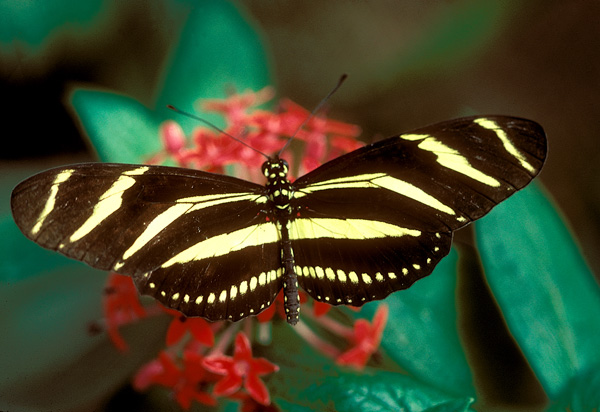Activity / How-To
Backyard Beauties

By Elaine Robbins
5 easy tips to help you get started in butterfly watching today.
“The highest enjoyment of timelessness,” wrote novelist and lepidopterist Vladimir Nabokov, “is when I stand among rare butterflies and their food plants. This is ecstasy, and behind the ecstasy is something else, which is hard to explain. It is like a momentary vacuum into which rushes all that I love.”.
You, too, can enjoy the transcendent beauty of shimmering butterflies feeding at dazzlingly colored flowers. And there’s no better place to pursue this experience than here. Texas is blessed with two monarch migration flyways and 430 species of butterflies — far more than any other state. The Rio Grande Valley alone has more species than all of eastern North America combined. Although you can see butterflies year-round, the best viewing is in fall and spring, and late October is the peak time.
If you want to deepen your enjoyment of watching butterflies, here are five ways to get started:
Find a Field Guide
Several new field guides make butterfly identification easy. Two excellent
choices for beginners are the Kaufman Focus Guide to Butterflies of North
America and Stokes Beginner’s Guide to Butterflies. Both have color
plates organized by family, so you can learn to identify butterflies first
by family (swallowtails, whites and sulphurs, brush-footed butterflies,
for example) and then by species (pipevine swallowtail, cloudless sulphur,
gulf frittilary).
Buy Close-Focus Binoculars
While you need long-distance viewing for birding or hunting, to open your
eyes to the exquisite close-up world of butterflies, you’ll need
a pair of close-focus binoculars. Look for models that focus at six feet
or closer. Eagle Optics Ranger Platinum Class 8x32 is an excellent lightweight
choice that focuses down to 3 feet and has light-gathering ability comparable
to larger models. Pentax’s Papilio 6.5x21 is a compact pair that
focuses down to an amazing 1 1/2 feet. It has a wide field of view, which
makes it easier to spot what you’re looking for. Kahles 8x32 is
a lightweight choice that focuses down to 5 feet and produces a crisp,
bright image.
Take Photographs
Butterflies are beautiful subjects for photography, but they’re
also notoriously skittish subjects. “I tell people that they have
to stalk the butterfly as though they are hunting,” says photographer
Larry Ditto, whose butterfly images appear frequently in this magazine.
“The closer you get, the lower profile you have to take. Sometimes
you need to get down on your knees and elbows. Butterflies seem to perceive
that something large is looming over them, so try not to cast your shadow
on them.”
You’ll need a camera that has a telephoto lens or a 100mm macro lens for close-ups. “Most of the time I like to get down on the same level as the butterfly,” says Ditto. “You’re trying to get those big flat wings on the same plane as the camera.” Ditto also recommends using a flash to bring out the color in butterfly wings.
Plant a Butterfly Garden
If you want to attract butterflies to your garden, find a sunny spot and
plant large patches of one or two of their favorite flowers. Butterflies
flock to salvia, lantana, butterfly bush, butterfly weed, mistflower,
Indian blanket and purple coneflower. Avoid insecticides and pesticides
— even organic ones. They can kill butterflies and their caterpillars.
Take Off
For the best butterfly watching experience in Texas, head to Mission in
late October for the annual Texas Butterfly Festival. The festival features
several days of field trips and seminars by the nation’s top experts.
While you’re in Mission, be sure to see the International Butterfly
Park.
Of course, one of the best things about butterfly watching is that you don’t have to go tromping around the world — or get up at 6 a.m. as you do for birding — to enjoy it. On some sunny afternoon, just head to your local botanical garden — or better yet, to your own backyard — and discover an exquisite, tiny world just waiting to be found.
———This article appeared in the October 2006 issue of Texas Parks & Wildlife. If you’d like to read more articles like this or subscribe to the magazine, visit www.tpwmagazine.com/.
 Texas Parks and Wildlife Department, 4200 Smith School Road, Austin, TX 78744
Texas Parks and Wildlife Department, 4200 Smith School Road, Austin, TX 78744


